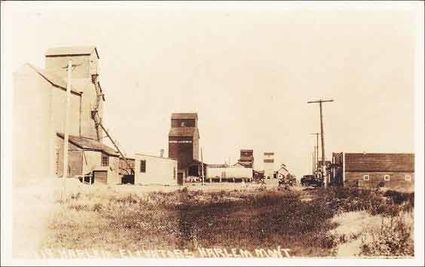Speaker presents about "Montana towns: then, now and tomorrow"
May 2, 2018

Hal Stearns, from Missoula, brought the third in a series of programs sponsored by the Harlem Senior Center and the Harlem Library through Montana Humanities. Stearns' presentation, titled "Montana towns: then, now and tomorrow," showed how small places and towns in the state play such a big part in the Montana story.
The Harlem Library and Harlem Senior Center recently hosted the third of their Montana Humanities Conversation series. A break in the weather brought a sizeable crowd to the Senior Center dining hall for a presentation by Hal Stearns of Missoula. Stearns was born in Havre and grew up in Harlowton. He describes himself as an "historian, storyteller and guide."
During introductory remarks Stearns said, "We are loosing our small towns. Not just in Montana, but across the country." In his presentation he shared some of the reasons why small towns often dwindle and, in some cases, disappear, while others seem to thrive and flourish. "Montana," he said, "is a state of extremes from its geography and weather to its population distribution. Half the population of the state lives in just five communities, another third lives in ten additional towns."
The remaining 134 incorporated towns were built around gold, coal and oil, timber, cows and sheep, early trails, roads and rails." The question is, "Why do some of these towns hang on and others drift away? And should we care?" The presenter said a discussion helps us understand that small places are a big part of the Montana story. Before the discussion, he gave a quiz. Here are a few selected warm up questions to get you thinking about small towns generally and especially small towns in Montana.
What are the towns that make up the four corners of Montana? In the northwest it's Yaak, northeast is Westby, the southeast corner is Alzada and the southwest corner is Monida (sometimes Darby because Monida is nearly gone).
What is the smallest incorporated town in Montana and why did it change its name for a time? Ismay is the smallest incorporated town in the state and, for a time, by a 21-0 vote of its citizens, changed its name to Joe. A Kansas City radio station contacted a couple of other small Montana towns before it got a hit in Ismay.
The radio station, as a publicity stunt to celebrate Joe Montana's joining the KC Chiefs, wanted to find a Montana town that would change its name to Joe, Montana. Long story short, the town changed its name and began selling merchandise featuring the town's new name. Over a few years they sold enough merchandise to buy a new fire truck and build a community center with a fire hall around it. Then, they changed the name back to Ismay.
Every school child knows there are 56 counties in Montana. Most probably know that license plates in Lincoln County (Libby) carry the number 56. But how many know "the last county to be created and the number on its license plates?" The last county created in Montana was Petroleum, in 1925, when it was separated from Fergus County. The number on license plates from Petroleum is 55, not 56 as would be expected.
Already you see some of the complexity of learning about small places, how they came about and how they were named. Studying how place names came about is known as "toponymy," a topic of another one of Stearns' quiz questions.
"We must do a better job of telling our story"-Hal Stearns
Stearns used photos of various small towns around Montana to illustrate his points about the demise of some towns and the success of others. One point he made about successful towns that find a way to succeed is that they understand the importance of "and"... He explained that "and" allows groups in a town to collaborate and find ways to build up their town by combining their strengths. The chamber of commerce 'and' the local teachers might collaborate to help students do internships with local businesses to learn about different career opportunities.
Another community action Stearns described was "look for things in a community that you can promote." He shared several examples of communities that used some historical incident or unusual geographic setting to build an attraction for their town. Several towns have become destinations for tourism and economic growth when an old hotel or declining eatery was fixed up and became an economic engine for other businesses in a small town or place.
He described an area he visited on a trip where the employees of each café, motel or amenity he visited referred him on to another place "he might also enjoy." Stearns said, "It was like they were all promoting the other businesses in their community as well as the next community."
He used that example to talk about how the area along the Hi-Line from Havre to Malta could be viewed as "a string of pearls." Stearns explained, "At points along the way you have various attractions and businesses you could promote as a region, from Havre's Beneath the Streets to the museums at Malta and various points in between." He added, "It's telling visitors what you know about your community and as well as the neighboring areas. It's all about doing a better job of telling the stories of our small towns."



